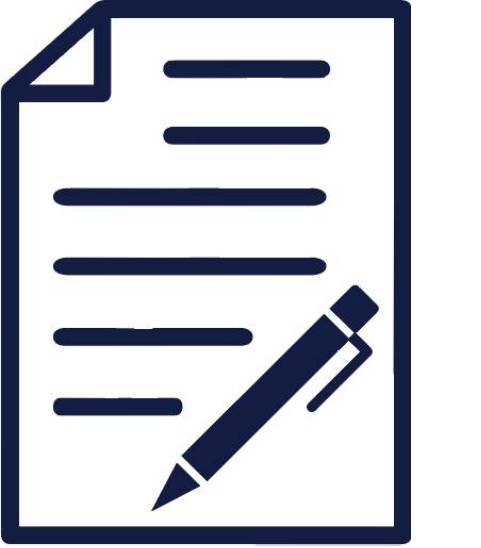Explore the best decking materials on the market, from premium plastic decking (PVC) to 100% recycled wood-plastic composite decking boards and exotic or tropical hardwoods.
Whether you are looking for maintenance-free decking in the form of aluminium decking or natural pressure-treated softwood timber decking that will require maintenance throughout the year, we compare the prices of each type and the pros and cons of the materials to give you the best start when planning your next outdoor project.
Quick Summary
| Softwood | Hardwood | Thermowood | Composite (Hollow Core) | Composite (Solid Core) | PVC | Aluminium | |
|---|---|---|---|---|---|---|---|
| Lifetime Value | Low | Med | Med | High | High | High | High |
| Long Lasting | Low | Low | High | Med | High | High | High |
| Maintenance Level | High | Med | Med | Low | Low | Low | Low |
| Enviro Friendly | Med | Med | High | Med | Med | Med | Low |
| Toxicity Level | Med | Med | Low | Low | Low | Med | Med |
| Load Bearing | Med | High | Med | Med | High | High | High |
| Water Resistance | Low | Low | Med | Med | Med | High | High |
Scroll table to see more
The above table shows the properties and benefits of a selection of different decking options available. To summarise:
If you are looking for a decking board with high water resistance, then a PVC decking, such as our Cladco Nordeck decking, or aluminium decking, is the best option.
If you need a low-maintenance deck that is also environmentally friendly, then consider composite decking for your project.
For a low initial cost with that real wood look, then pressure-treated timber decking is going to be your best option.
1. Cost of the decking material
Choosing the best decking materials will depend on your budget as well as how long, or how often, you intend to use the deck. It's important to think of price and cost as two separate things, with the latter referring to how much the deck costs over its lifetime. Price refers to the initial outlay, so you should consider which additional decking materials to include when buying. This will include additional items such as starter clips, screws, joists and finishing touches. Do you need end caps for hollow core composite decking, or bullnose and fascia trims for raised decks and 'picture-framing' an area?
Timber will be cheaper on the initial outlay but will require ongoing maintenance, such as annual staining or treatment, increasing the lifetime cost with the possibility of having to replace boards depending on annual weather conditions.
Cladco offers a range of decking options, each with its own benefits and warranty coverage. Our composite decking ranges — Signature and ProDeck — come with 15-year and 20-year warranties, respectively, and require minimal upkeep. Cladco Nordeck PVC decking also offers a 20-year warranty and is designed for low-maintenance performance over time. Aluminium decking boards are ultra-low maintenance and backed by a 20-year warranty, although they do come with a higher initial cost. For a more natural option, our bamboo decking is highly durable and hardwearing. While it does require regular maintenance to preserve its finish, it is supported by a 10-year warranty.
2. Durability of the decking material
With increased durability comes an increase in the initial price, as well as longevity, of the deck. Nordeck decking features a PVC core that is capped in a hard-wearing, water-resistant ASA-resin shell. This is best suited for areas prone to water, such as around pools or larger water features.
Composite decking is manufactured from recycled hardwood fibres and recycled plastic and offers low-slip properties or a high-quality woodgrain effect, with excellent durability underfoot. This is perfect for garden transformations, or covering over unsightly concrete, for example.
Opting for aluminium provides additional benefits, including fire ratings for balconies and high-rise building projects to meet building regulations. As a highly durable material, aluminium decking could be the best option for commercial projects, for example, where durability is the number one priority.
For those who value sustainability without compromising on strength and durability, bamboo decking delivers a striking, timeless beauty with its rich, dark natural tones, creating an outdoor space that’s both eco-conscious and truly unique.
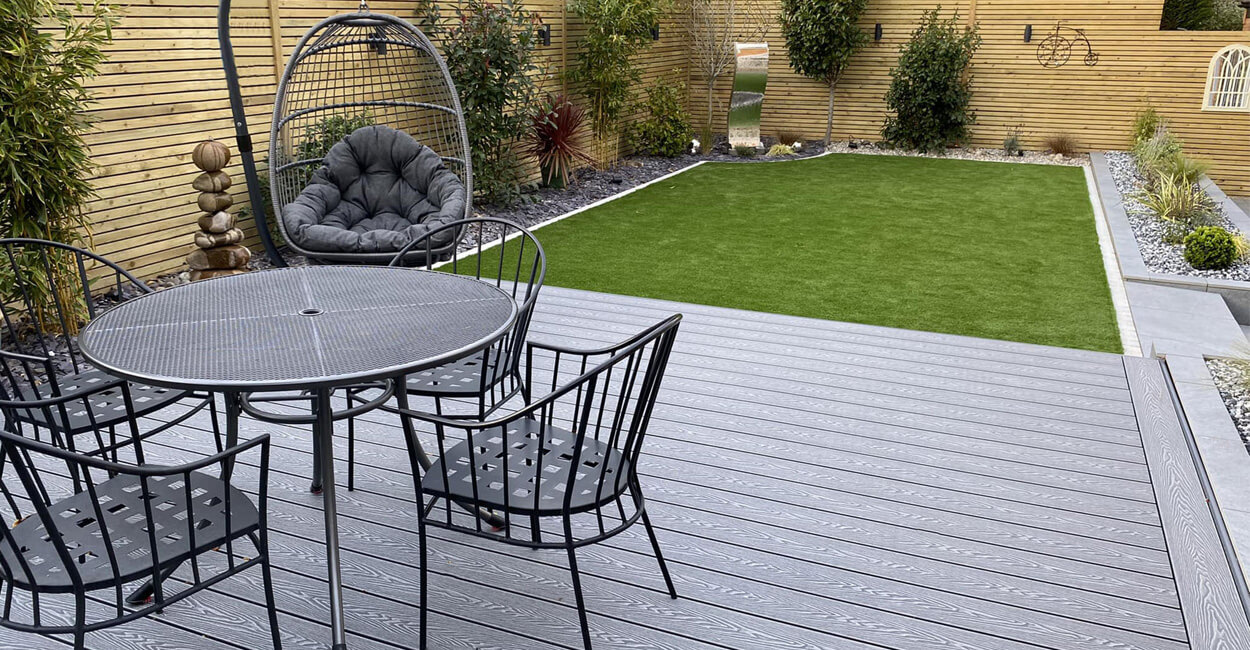
3. Maintenance of the decking material
All decking materials require some level of maintenance to keep them looking their best. Pressure-treated wood decks typically need regular upkeep each year to maintain their appearance. In contrast, composite and PVC decking are much easier to care for, usually only needing an occasional wash as necessary. Depending on your deck’s location, such as under leafy trees or near berry-producing bushes, you might want to invest in a composite deck cleaner or consider using a pressure washer to tackle tougher dirt and debris.
As is the case with anything subjected to seasonal changes throughout the year, composite decking may need some extra care and attention over PVC decking. For example, due to the natural fibres in composite boards, expansion and contraction will naturally occur. Timber and bamboo decking will be the most demanding and costly, with staining and treatment being a requirement to keep your deck looking as good as the day you bought it.
4. Environmental impact of the decking material
The environmental credentials of decking materials are important. Cladco composite decking is manufactured from 100% recycled materials, comprising 60% FSC®-certified recycled hardwood fibres and 40% recycled plastic, making for an environmentally friendly product that supports sustainable forestry and reduces plastic waste.
Timber decking that is preserved with chemical-based preservatives can be damaging to the environment if applied incorrectly or not properly monitored and maintained. PVC decks are completely man-made, so they have a higher environmental impact than other types of decking materials.
5. Toxicity of the decking material
It's important to know what's in your deck boards and how they've been treated. When opting for timber decking, which has naturally occurring oils and natural tannins by default, treatment through staining and painting can affect the deck's toxicity level and may not be the right material for your environment.
Composite decks are manufactured from recycled natural wood fibres and recycled plastics, which have been combined using glues, tints and dyes to form the colour across a solid form. Once combined, unlike treated wood, a composite deck does not require varnishing or sealing to keep it looking new.
Thermowood is pressure-treated wood that is free from chemicals. Unlike other wood decks, which are preserved using chemical processes, Thermowood is a non-toxic deck material.
6. Decking Use
A few factors will come into play when considering different types of decking. Cladco Signature composite decking is designed for outdoor spaces that experience lighter footfall and smaller pieces of furniture. The hollow, five-hole honeycomb core design forms the centre of these boards, reducing overall weight for installation and the price per board.
Cladco Signature solid composite decking is best for busier deck spaces that will be subjected to greater footfall, heavier furniture and ornaments. Improved soundproofing underfoot is an additional benefit of this type of decking.
Cladco ProDeck composite decking also features a hollow core design, but thanks to its advanced capped-polymer surface, it has enhanced durability and is ideal for premium projects requiring superior structural integrity and load-bearing capacity.
PVC decking, as opposed to composite decking or traditional wood, does not contain any natural wood fibres, and so has improved water resistance, making it best for use around pools, water features, or in areas which are prone to standing water.
Decking options...
Wood Decking
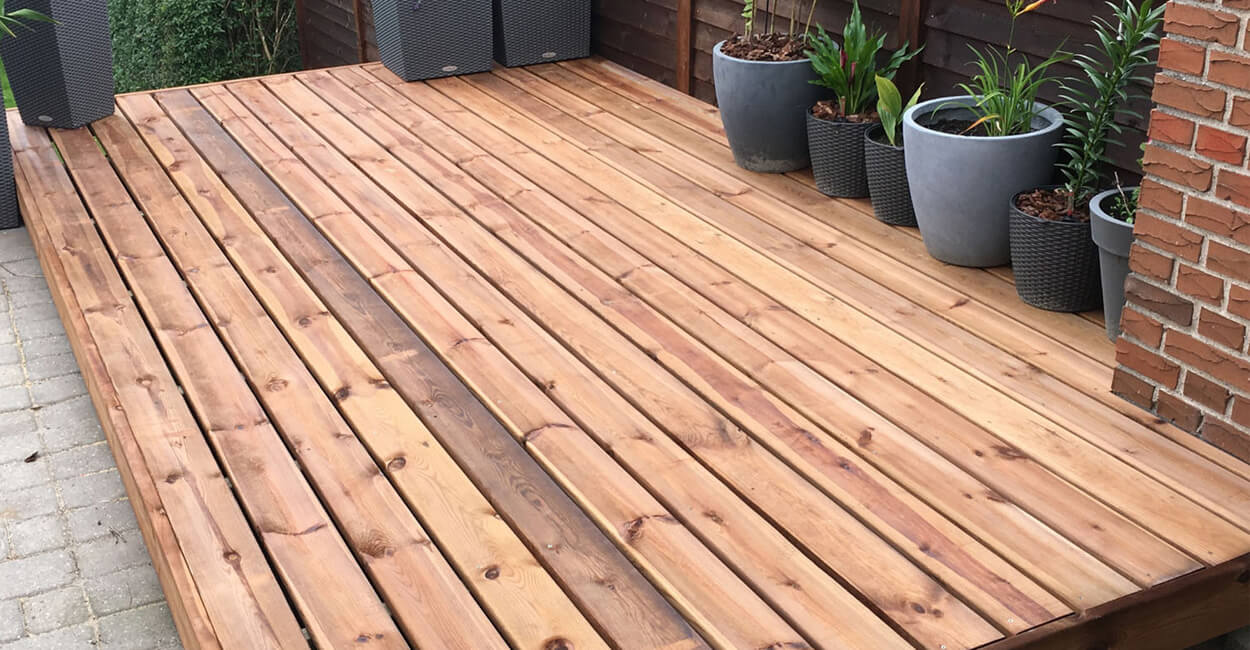
Traditional wood decking materials come in the form of softwood, hardwood and Thermowood (heat-treated softwood). Pressure-treated wood is where natural wood is impregnated with preservatives and chemicals to give it a longer lifespan, which has its benefits in an outdoor setting.
Softwood
Softwood timber decking is made from a common decking material, such as spruce, pine, larch, redwood and cedar types, and is known for being durable and lightweight. Softwoods range greatly in softness, and a common misconception is that all softwoods are softer than hardwoods, which isn't necessarily the case. For example, balsa is a hardwood but is the softest wood in the world.
Cladco timber decking is manufactured from softwood spruce and is green pressure-treated with preservatives, making this ideal for use in the construction of decking areas.
Pros
Cheap initial purchase price
Easy to work with and install
Real wood textures
Cons
Susceptible to rot and mould
Can splinter or crack
Requires regular maintenance
Softwood decking is one of the most affordable options, costing approximately £22 per m².
Hardwood
Typical hardwood decking materials include oak, walnut, ash, beech and maple, to name just a few. Usually, from climatic conditions including temperate and tropical, hardwoods are commonly used in the construction of furniture, flooring and higher-quality, timber-based products that are naturally resistant. Picked for its long-lasting qualities, a deck design featuring these types of decking materials will usually outlast softwood decks.
Pros
Natural timber grain
Strong, high tensile strength
Increased resistance to rotting
Cons
Ongoing maintenance required
Harder to install and heavier
A more expensive form of timber
The price of hardwood decking per m² can vary vastly depending on the type of timber. Expect to pay between £25-£50 per m².
Thermowood
Thermowood decking is produced by heat-treating certain wood species with a process that is chemical-free, using just steam and heat vapour to improve durability and longevity. Created from softwood species, for example, Scandinavian pine, this environmentally-friendly wood deck has improved moisture resistance and insect resistance over an untreated wood deck.
Pros
Chemical-free, recyclable deck
Enviro-friendly
Dimensionally stable
A variety of wood types are available
Cons
More expensive than other timber
Burns quickly due to low moisture content
Susceptible to splitting
Expect to pay between £30-£60 per m², depending on the wood type.
Composite Decking
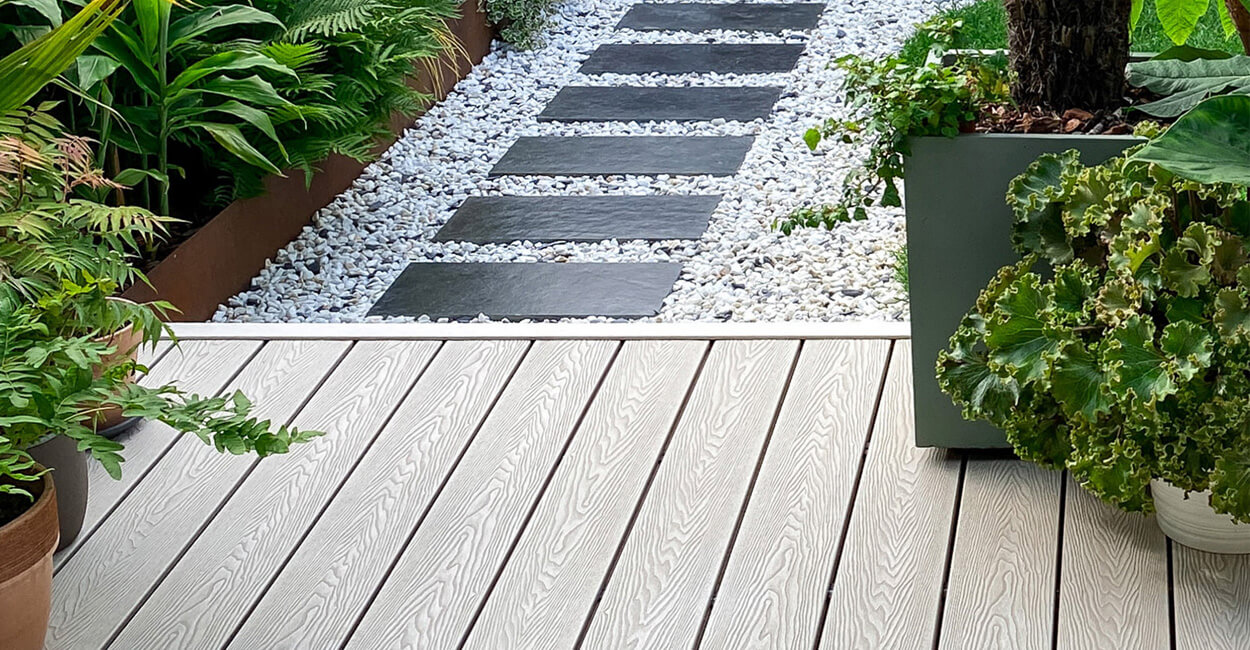
Composite plastic-wood decking is available with either a solid or hollow core construction. Manufactured from 100% recycled materials, formed of 60% recycled hardwood fibres and 40% recycled plastics, composite decking is an environmentally friendly product. Available in a wide array of colours, Cladco's Signature and ProDeck composite decking boards are dual-sided, featuring either a narrow grooved or a high-quality woodgrain effect design.
Composite decking materials come with many benefits over wood decks, including being resistant to rot and insect damage. Due to the natural wood fibres within the boards, composite decking will expand and contract slightly with the changing ambient temperatures throughout the year.
Hollow Core
Uncapped composite decking, also known as domestic grade hollow core, is lighter in weight due to the reduced amount of materials used within its construction. Cladco hollow core decking features a five-hole honeycomb internal structure, making it strong and durable. To finish off hollow core decking, end caps can be used to seal the exposed ends.
Pros
Environmentally friendly
Low maintenance
No sanding, painting, or treating required
Insect and pest-resistant
Slip resistant
Various deck colours available
Safe for bare feet
Cons
Requires capping to close off deck ends
Boards may fade after exposure to harsh sunlight
Hollow core composite decking costs approximately £38 per m².
Solid Core
Solid core composite decking is a commercial-grade composite wood decking that provides extra soundproofing underfoot. Due to the solid construction of these composite decking boards, durability is increased and no capping is required. For raised decking spaces with steps, these can be the best decking materials for these types of installations.
Pros
More durable and heavier duty than hollow core
Improved soundproofing underfoot
Can be cut with normal woodworking tools
Rot and insect-resistant
Ideal for heavy furniture and increased footfall
Safe for bare feet
Cons
Heavier to carry
Increased initial costs over timber or hollow core composite
Boards may fade after exposure to harsh sunlight
Higher initial costs than hardwoods or softwoods
Solid core composite deck boards cost approximately £56 per m².
PVC Decking
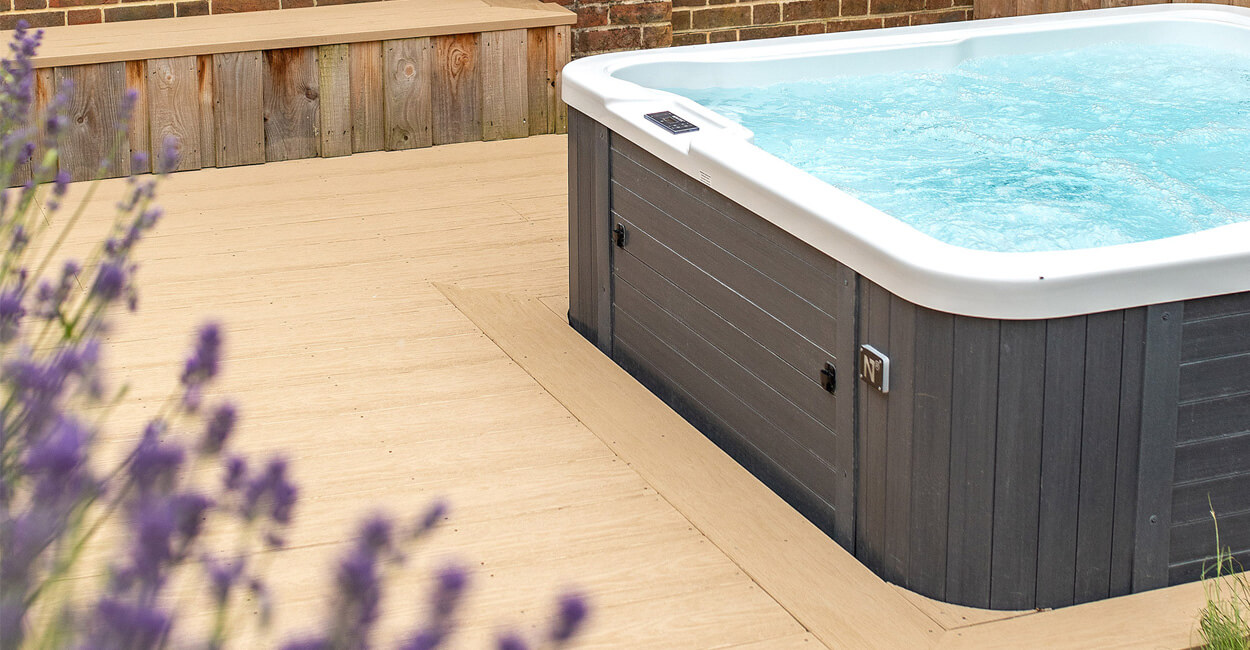
Cladco Nordeck decking is a form of solid plastic decking, as opposed to hollow vinyl decking, manufactured to a premium standard using a PVC core that is encased in ASA resin. Nordeck decking is easy to clean and extremely water resistant due to the fact there are no natural wood fibres that could expand or contract. As a premium composite deck type, Nordeck boards offer a wider board coverage at 200mm compared to composite deck boards or timber boards.
Pros
Low absorption rate
Wide 200mm board coverage
Rot, scratch and warp resistant
Strong and durable, suitable for heavy loads
High-quality woodgrain effect
Cons
Manufactured from 100% man-made materials
More expensive than timber or composite
A Nordeck Deck costs approximately £95 per m².
Aluminium Decking
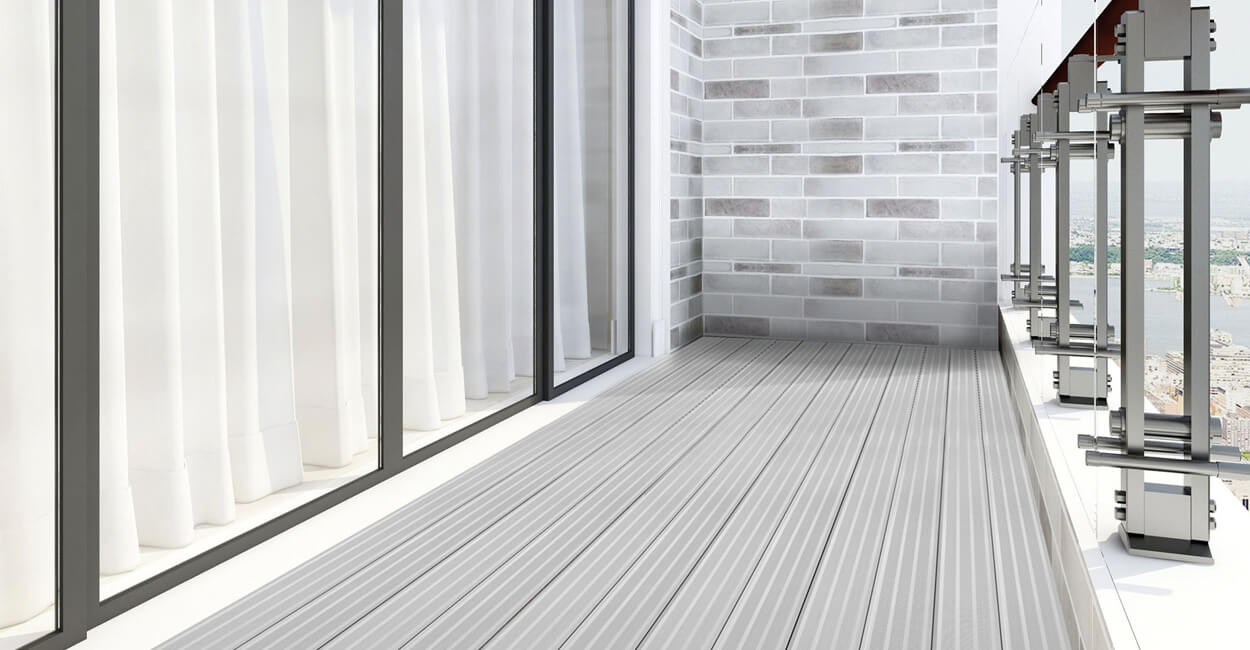
Unlike wood types, aluminium decking is chosen for new deck designs that need to meet certain building regulations, for example, decks over 11m above the ground. As a premium decking board, this type of metal decking is fire resistant (fire-rated to A2-S1), maintenance-free and can last a lifetime.
Pros
Fire-resistant properties (A2-S1 rated)
Meets building regulations for balconies
Hard-wearing decking surface
Durable powder-coating
Extremely long-lasting (lifetime warranty)
Cons
Expensive board price on the initial outlay
Requires specific tools to cut and work with
Aluminium decks cost approximately £140 per m².
FAQs
What is the cheapest decking material?
Timber decks are the cheapest to purchase on the initial outlay, but with more maintenance required throughout the lifetime of the boards, this will increase long-term overall costs. A composite deck (Signature or ProDeck) and PVC decking (Nordeck) require little maintenance, which keeps long-term costs to a minimum.
What is the longest lasting decking material?
The longest-lasting deck from the above-mentioned deck types is aluminium. This is a deck type that offers the best resistance to fire, moisture, insect damage and rot, and can last a lifetime.
What is the best low maintenance decking material?
The low maintenance requirements of aluminium decking make this type of deck the easiest to maintain, followed closely by PVC decking. An annual visual check is all that is required to ensure that debris is removed from the surface of the deck. A composite deck is also low maintenance, but it may require a specific composite deck cleaner to remove a tough stain or mark. A timber deck requires a visual check every few months to keep on top of debris and objects, such as plant pots, that affect the wood.
What is the most cost effective decking material?
Composite boards offer excellent short-term value, with our Signature range backed by a 15-year warranty. If you're planning to keep your decking area for longer, our polymer-capped ProDeck or Nordeck PVC decking are more cost-effective in the long run, each offering a 20-year warranty and requiring minimal upkeep, making them cheaper per year than real or treated wood. For a truly long-term investment, aluminium decking is the most durable option available, lasting a lifetime with ultra-low maintenance, though it does come with a higher initial cost.
If you would like to speak to us about any of the Cladco decking products mentioned above, please give our friendly Sales Team a call on 01837 659901.

